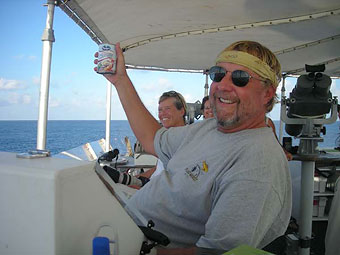

 | |||||||
|
|
Journals 2007/2008Heather Judkins
November 27, 2007 So, what kind of money does it take to run this type of operation? There is expensive equipment, fuel, salaries, food, ship maintenance and technology involved with running a long-term observation survey. This STAR-LITE cruise was a four month cruise involving approximately 60 people between ship crew and scientists to make it run smoothly. There are also support teams on land that are in constant communication with the ship, both NOAA and the Southwest Fisheries Science Center. Here are some of the items/services and their approximately cost:
 Richard Rowlett, Senior Marine Mammal Observer (STAR-LITE) Richard has been intrigued by nature since he was in school where he started observing birds. His first cruise was in 1972 and he has been working on survey projects around the world ever since. He worked for a time with world fishery and whaling projects where he learned about the sea from the fisherman's perspective and then he began working with marine mammal surveys so over time, he has become well-rounded in his knowledge base for many projects. His primary responsibility is to oversee the mammal observations and check over daily data forms before they are entered. He thinks the greatest challenge for these types of extended cruises is the adjustment from at-sea to shore. The ship seems to run like a small, floating city with only 35 people onboard for months and then you get back to land and there's lots of "frenzy." The most rewarding part of his job is the worldwide travel he would not have done otherwise. He has seen some things others will never have the chance to see in their lifetime. One of his favorite memories is of a right whale encounter coming back from Antarctica- the large whale had thousands of sea lice covering his body and began to rub itself off on the side of the whaling ship. Richard could literally pick off the sea lice if he wanted to. He didn't, but took many pictures! The whale didn't stop rubbing and the captain made some adjustments to move away from the friendly whale and the whale continued to follow! Just think, the whaling ship being hunted by a whale! His words to live by are "live for the spirit of adventure". Marine Science Questions: 1. What is your best estimate for the overall cost of this type of survey operation? (hint: use the information above and you should get close) 2. We saw short-beaked common dolphins riding the bow this morning. What similarities and differences are there between them and the bottlenose dolphins in the Gulf of Mexico? |
||||||